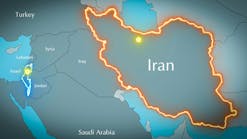Buoyed by natural gas price increases over the last three years, unconventional gas development is steadily impacting US and Canadian gas supply. This article provides an overview of unconventional gas and the issues and drivers in this important part of the E&P business
Don Warlick - Warlick International, Houston
The history of natural gas development is largely a story of conventional drilling and completion. Conventional gas reservoirs were originally formed in shale and limestone formations. The gas migrated upwards until trapped by geologic faults or folds, ultimately to reside in a reservoir rock until discovered, drilled, and produced. These conventional plays are trap scenarios - as opposed to unconventional gas, which is deposited in continuous accumulations.
Photo courtesy of Anadarko
By definition unconventional gas includes gas shales, coalbed methane (or CBM), and tight gas. This article provides a look at the first two important areas of unconventional gas - coalbed methane and gas shales, based on their importance to the North American gas supply.
At the end of 2005, production from gas shale basins accounted for about 8% of US total gas production while CBM accounted for another 8%. CBM in Canada is a lesser share, about 2% of total production. Canadian gas shale production is limited right now but has potential to grow.
Gas shales
US and Canadian gas shale reservoirs include some of the oldest-known gas production as well as current development plays. There are over 39,500 producing gas shale wells in the US today.
Gas shale reservoirs range in depth from a very shallow 250 feet to as deep as 8,000 feet. The majority are usually between 2,500 and 4,500 feet, and typically the shale is from 300 to 600 feet in thickness. In the US the total gas shale resource is estimated in a range from 500 to 600 tcf and in Canada more than 1,000 bcf. The Energy Information Administration (EIA) estimates that shale gas could provide up to 15% of the technically recoverable natural gas resources in the US over the next 18 years.
The accompanying map (Significant US Gas Shale Basins) identifies the various gas shale areas and basins in the United States. In Canada gas shales (and CBM basins) are located in the Western Canadian Sedimentary Basin, a huge swath across the lower three-quarters of Saskatchewan, all of Alberta, and the northeast corner of British Columbia.
Shale gas development in the Western Canadian Sedimentary Basin (WCSB) is in its infancy but exploration is going forward in a variety of locations and stratigraphic intervals. A special 2002 Gas Technology Institute report determined that the WCSB held 86 tcf of shale gas in place, but recoverability wasn’t established.
Gas shales are fine-grained rocks where the predominant gas storage mechanism is sorption in volumes that are potentially economic. They are unique when compared to most hydrocarbon reservoirs in that shales are most often the source of the gas as well as being the reservoir.
Gas shale reservoirs are generally composed of low-permeability, low-porosity matrix rock where the majority of gas is stored and then a system of natural fractures that supply most of the transmissibility in the reservoir. Shale is the most common sedimentary rock on earth. In many oil and gas fields, shale forms a geologic seal that retains oil and gas within producing reservoirs. Shale can be hundreds of feet thick and cover over millions of acres.
Gas shales will generally have low permeability, low production rates and recovery factors that can be a fraction of conventional reservoirs. Even though gas shale wells flow at low rates they will produce at stabilized rates for long periods of time. Commercial production will always depend on drilling and completion costs. Also important, hydraulic fracturing will often be required to accomplish economic gas recovery.
Typical early production rates may vary between 100 - 500 Mcfd in many of the gas shale reservoirs, while the Barnett shale will have early recovery rates often exceeding 1 MMcfd. Recovery factors between fields and within fields can vary between 5% and 20% with production life often exceeding 20 years.
Using the Barnett shale as an example, development plans today will call for horizontal completions, many producing around 1 MMcfd. If an operator in the Barnett completes 6 of these wells per square mile then total production will be 6 MMcfd per square mile.
In the Tier 1 or core area of the Barnett, reserves can offer around 120 bcf per square mile. The result: a theoretical producing life of 20 years for those 6 wells.
We have analyzed the top gas shale basins in North America - those that account for the majority of production from all gas shale reservoirs. These selected areas/basins are summarized in Table 1.
null
Coalbed methane
Today in North America there are 16 coalbed methane areas that are of interest and/or have measurable production and drilling activity, indicated in the accompanying map (Significant US CBM Basins). CBM fields in Canada, just like Canadian gas shale areas, are located in the Western Canadian Sedimentary Basin.
CBM is a natural gas produced from coal seams or adjacent sandstones where coal is both the source rock and the reservoir for methane production. Whenever organic material like coal is buried, temperature and pressure increases will cause methane, water, and other substances to be liberated. When these fluids are released, the organic matter contracts, causing fractures. These are called cleats, providing permeable pathways through which fluids and gases flow.
Some gas may escape the coal, but if formation pressure is sufficient, quantities of methane are retained in the pressurized coal matrix in an adsorbed state. To extract and produce the methane, wells are drilled into the coal and pressure is reduced by dewatering or pumping out formation water.
All coals will have significant surface area that can hold massive volumes of methane via adsorption. Accordingly these coal beds will have large internal surfaces that can store 6 to 7 times more gas than an equivalent volume of rock in a conventional gas reservoir.
Permeability will be an important characteristic since the coal bed must allow the gas to move once water pressure is reduced. Coalbed methane gas in higher-rank coals is created as heat and pressure transform organic material in the coal while gas in low-rank coals results from decomposition of organic matter by bacteria.
Coal beds are both the source of the gas generated and the storage reservoir when gas is produced. In most cases, coals can generate more gas than they can adsorb and store. Typically, basins containing 500 to 600 standard cubic feet of methane per ton (SCFT) are considered favorable for commercial CBM production, given sufficient reservoir permeability and a good adsorption rate. At the high end, some unique coals can generate more than 8,000 SCFT.
The most productive coal beds are highly permeable, saturated with gas, and fractured. Methane is attached to the surface of coal and also throughout fractures, held in place by water pressure. When the water is released, the gas flows through fractures into the wellbore.
Most CBM wells will be shallower than 5,000 feet and are often in the 1,000-foot to 2,000-foot range or less. For deeper coals, there will be less water in the fractures but it will be more saline. Gas volume nearly always increases with coal rank, depth, and reservoir pressure.
Coal reservoirs are not homogeneous. Even in the same area, they may have different reservoir and geological characteristics. A CBM reservoir is usually not a single-coal seam but will have multiple thin coal seams inter-bedded with shales and sand. Reservoir characteristics like permeability, saturation, pressure, and gas content and geological make-up such as coal rank, thickness, and natural fractures determine the productivity potential of the reservoir.
Almost all North American CBM developments must be dewatered, often for several months, before gas production begins. When the coal bed’s fracture system produces water, its adsorptive capacity is exceeded. Pressure will then decrease, and the gas trapped in the coal matrix starts to desorb and migrate into the voids in the fracture system. Transported gas can remain stored in nearby non-coal reservoirs until produced.
Stepwise, CBM field development starts with drilling, then dewatering, and finally desorption. Gas production comes on as water production falls off. This produced gas is most often of sufficient quality to be sent directly into nearby gas gathering and pipeline systems.
Dewatering volumes will vary widely: CBM wells in the Cherokee Platform hardly produce any water at all, an advantage to early production. The average San Juan CBM well produces about 25 barrels of water per day. In the Powder River basin, the average CBM well produces 150 barrels of water a day (but initial water production could range from 400 bpd to 1,500 bpd in deeper wells).
Final disposition of this water obviously impacts project economics where disposal versus reinjection will depend on quality or re-usefulness.
Our analysis of leading CBM basins in North America, which account for significant or majority share of total coalbed methane production from all CBM reservoirs, is summarized in Table 2.
Not all unconventional gas development will call for high-tech solutions. Rather, they need appropriate, cost-effective applications with good technology content. Two examples: Significant advances in big-play horizontal programs are being accomplished in the Barnett - then there are the “right” applications of inexpensive horizontals by El Paso in Oklahoma, where price is important.
Gas shale and CBM gas development is highly influenced by service costs as well as natural gas prices. Technology implementation and use will vary widely - in the smaller unconventional basins where primary operator makeup is largely small independents, there is natural resistance to technology perceived as expensive. But in basins like the Fayetteville or Barnett, there is much broader use of high-end technologies because of repeatable, predictable success.
As the Barnett progresses in its growth and technology applications, it has served as somewhat of a laboratory to develop and enhance special services - testing on a well, analyzing results, going back with a change on the next one, and so on. Then operators apply findings to, say, horizontal or fracturing techniques as well as other services.
That learning is now being taken to other basins. Service company commitments should then be focused on cost-effective technologies - important in these times of dynamic gas price conditions.
What’s ahead for gas shale and CBM
Our analysis and review of unconventional gas development in North America indicates that 2006 should end up being a very positive year:
- Gas shale drilling could be up 30% over drilling in 2005 due to big increases in the Fayetteville, Woodford/Caney shales and a steady uptrend in the Barnett; and
- CBM drilling could also increase in a big way - by more than 20%, thanks to Canada, the Cherokee Platform, and good performance in the Powder River and San Juan basins.
But what happens in 2007? During Q3 and Q4 of this year natural gas prices softened greatly. The biggest reason: Huge pre-winter inventories that have been building up since last year have backed down prices. The natural gas drilling boom that initiated in the spring of 2002 is running into a real and perceived jam-up of stored gas. In late September a new pre-winter record high for working natural gas inventory was set in the US with front-month trading at $4.02 on 27th September, near the lows of November 2002.
There has been recovery since then but of course the winter heating season will hold sway over price directions, as has always been the case in North America. In the short term, this will be a winter bet tied largely to weather conditions through early February. Most of the industry foresees an improved to steady gas price environment in the longer term.
For gas shale and CBM development, there is, indeed, gas price sensitivity in the equation, more so than for established conventional developments. What are those important price levels at which unconventional drilling slows? It can vary by basin, development cycle, investment, and so on.
Areas that are several years into the gas shale development cycle, like Appalachian gas shale or the Barnett, may have a break-even or sensitive price near $5/mcf; those developments that are early-cycle like the Fayetteville or Woodford Shales can exceed $6/mcf. CBM break-even/sensitive price levels will be similar but one must remember the multi-month dewatering phase in most CBM developments that will precede gas production - that can give operators second thoughts on timing for E&D programs here.
Gas shale and CBM development have flourished with increasing gas prices since 2002 and have paid off by adding reserves and long-lived production to E&P portfolios. Together, gas shale and CBM production have grown and now account for about 16% of US annual gas production.
Smart implementation of appropriate technologies underlays the uptrend along with a more intelligent approach to unconventional gas field development. Now all those forces must come into play to make certain that future costs for development and operations can be controlled in the face of gas price dynamics in 2007 and beyond.
The author
Don Warlick [[email protected]] is president of Warlick International, a market and business consultancy established in 1977 that specializes in global energy.
UG report released
A comprehensive new report on unconventional gas is now available from Warlick International and PennWell Corp. Warlick has published a series of Strategic Energy Reports in partnership with the PennWell Resource Center, including an in-depth look at Libya’s upstream and midstream oil and gas markets and this latest report on unconventional gas in North America. The author, Don Warlick, will be a featured speaker at the Gas Shales Summit in Denver on Dec. 1. More information is available at www.ogj.com. Click on “Resource Center,” then “Business, Executive and Research Reports.”







